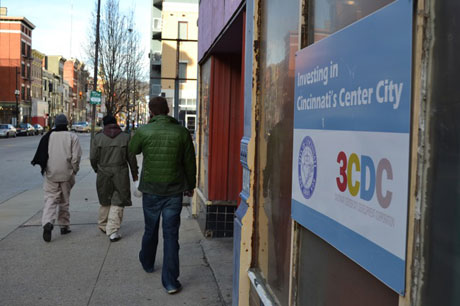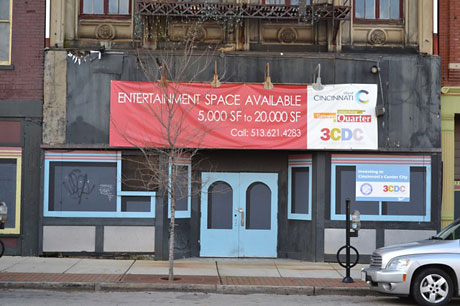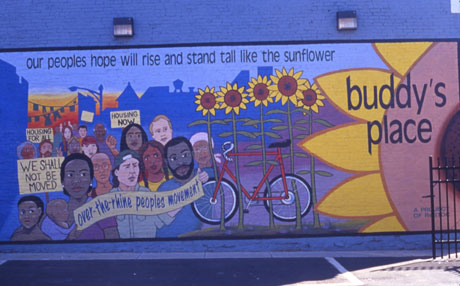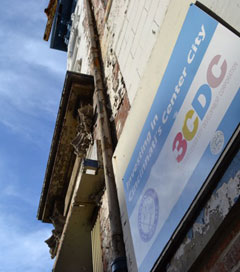Over-the-Rhine, Cincinnati's oldest and poorest neighborhood, predominately of color and listed on the National Register of Historic Places – has experienced quite a bit of notoriety over the last ten years. In April 2001, sparked by the police-shooting death of 19-year old Timothy Thomas, the neighborhood was wracked by three days of unrest, what the media continues to call the “riots.” In 2006, the National Trust for Historic Preservation listed Over-the-Rhine on its list of “11 most endangered places.”
And then more recently in November 2011, McClatchy Newspapers related a Census Bureau report that found that “from 2005-2009, a segment of Over-the-Rhine – Census Tract 17 – had the highest income inequality of more than 61,000 communities nationwide” (Pugh). Over-the-Rhine today is marked by the extremes of gentrification and homelessness.
In 2003, after the city abolished its Planning Department (it has since reinstated that department), it then helped form the Cincinnati Center City Development Corporation (3CDC) to lead development of downtown and Over-the-Rhine. 3CDC is not a typical corporation as its board of directors constitutes a who's who of the city's most powerful corporations. Since 2004, the corporate game plan has been swift, visible and deeply colonial.

(Photo: John Blake)
Over-the-Rhine offers an intriguing case study in illuminating what's occurring everywhere across the country when corporate and city government power merge to advance certain class interests under the cover of terms that suggest inclusivity, such as “economic mix” and “mixed-income development.” What's now happening in Over-the-Rhine is not so different from comedian Eddie Izzard's satire about Great Britain's domination of the world through colonization:
“We stole countries; that's how you build an empire. We stole countries with the cunning use of flags. Just sail around the world and stick a flag in 'em.
'I claim India for Britain.'
'You can't claim us, we live here. 500 million of us.'
'Do you have a flag?'”
Now, if you just shift scales a bit to see the internal colonial machinations of powerful corporations operating within a nation, it's not hard to extrapolate to see 3CDC playing the role of Great Britain in Over-the-Rhine.
3CDC: “We claim Over-the-Rhine for middle- and upper-class people.”
People of Over-the-Rhine: “You can't claim us, we live here. We've been building community for years, decades really. You can't just come into this community, claim it for yourself and run everybody out!”
3CDC: “Do you have a sign?”

(Photo: John Blake)
3CDC's signs are everywhere in Over-the-Rhine, a plethora of giddiness marking the neighborhood's “Renaissance” and “Rebirth.” Interesting terms, these: Renaissance and Rebirth. They are popping up everywhere, right in rhythm with 3CDC's signs. These terms brilliantly evoke the change in Over-the-Rhine that 3CDC advocates; they are labels that by their very meaning erase all understanding of the recent history of the neighborhood and the organizations that have been built by everyday, community people to address the fallout of a changing global economy that has made too many jobless and homeless.
Exaggeration?
Think of the Italian Renaissance of the 1400s and the so-called flowering of the new human spirit, marked by the great advances in art and architecture by artists such as Leonardo da Vinci and Michelangelo. What happened before the Renaissance? Doesn't matter. We call that time the Dark Ages. Nothing worthy to note really, except maybe the Black Plague.
Transport these terms to Over-the-Rhine today and the rhetorical strategy becomes clear. In one easy label – take your pick, Renaissance or Rebirth – the whole recent history of Over-the-Rhine is erased and any hint of the Over-the-Rhine People's Movement in its ongoing success to address desperate need and to build community is bracketed out, except when it is equated to the Plague.
You can get a flavor of what I'm talking about if you were to read “Cincinnati's 3CDC: A Model for Urban Transformation,” posted recently on the web site of the Urban Land Institute (ULI) (Sheridan).
Here's a sampling: “Only a few years ago, Cincinnati, Ohio's Over-the-Rhine (OTR) neighborhood was known for having one of the highest crime rates in the city. Today, the area – believed to be the largest, most intact urban historic district in the United States – has been transformed into one of Cincinnati's most vibrant sectors … The reason? Cincinnati Center City Development Corporation (3CDC)…. What 3CDC is doing is nothing short of remarkable … [OTR] was as depressed as any in the country. Now it is one of the best in America … We've had substantial corporate support, not only for our operating funds but our capital funds as well. The corporate sector has been terrific … The city has supported us all the way … 3CDC is a 'catalyst' real estate development company … [and it] has paved the way for the private sector to engage in the redevelopment effort … with the goal of guiding development in the city to create a built environment that is attractive to recruits to Cincinnati … 3CDC applied for and received new markets tax credits, which have been leveraged with tax increment financing through Cincinnati to subsidize development of mixed-use, walkable neighborhoods … “

(Photo: John Blake)
If you are hoping for any semblance of a critique of 3CDC's mission and practices, you will not find that here in ULI's article. That 3CDC walks on water comes as no surprise, given ULI's readership and focus. The article states accurately how 3CDC, the spearhead of corporate power in Over-the-Rhine, has been successful in implementing that corporate agenda.
Of course, that corporate agenda is not the only one worth considering. There are others, but they are completely missing in ULI's account. Thus, within the parameters that ULI cares about, the article is skillful. Matters change substantially when we excavate what the article assumes and leaves unstated.
So, what's missing? The article makes no mention of the fact that Over-the-Rhine is wracked by the extremes of gentrification and homelessness. There is no mention of economic inequality or joblessness. You will find no mention of the Over-the-Rhine People's Movement's history and success in building community against the overwhelming odds that cause too many to slide from helplessness to hopelessness to nothingness. No poor people, of any color, are in this text. Absent and invisible, they are written out, made to disappear in just the same way the real material forces of gentrification and police maneuvers push people out and supplant the indigenous culture.
Is it too much to ask of an article to portray current reality accurately?
Apparently. Because doing so may upset the apple cart; understanding the full dimensions comprising current reality in Over-the-Rhine may necessitate other measuring sticks to evaluate the “success” of 3CDC.
What might other sticks measure? How precisely is 3CDC addressing poverty, when much of its development has been upscale condos? How is it addressing inequality, when so few neighborhood people and small-scale contractors are employed in any of the new development? How is it trying to include those most down-and-out and homeless, when it schemes with the city to move the Drop Inn Center out of the neighborhood?
The article unquestioningly reproduces the commonsense assumption that market-rate development is always automatically good and that poor people will benefit just like all the new wealthier people moving in. This is the same old trickle-down nonsense we've been fed for decades. It's just not true and the research shows it (DeFilippis and Fraser, 2010, Fraser and Nelson, 2008).
We need a new paradigm for urban development, one based upon an honest analysis of what we are facing in Over-the-Rhine, an analysis that sees Over-the-Rhine as a microcosm of larger political-economic forces operating the world over. And what we're facing is not pleasant; in fact, it's catastrophic. The most central contradiction in the world right now is the relationship between the included and excluded – that because of massive inequality on a scale never before seen, the rise of the plutocracy and its control of politics, the downloading of the Wall Street bailout onto states in the form of austerity measures and the accompanying ideologies that prize market fundamentalism and individual responsibility to these structural conditions – we now have what philosopher Slavoj Zizek says is “new forms of social apartheid – new walls and slums” (to which we could add fortified corporate headquarters, gated communities, padlocked urban blocks, secured holiday resorts, self-enclosed shopping enclaves) where the state “perceives the excluded as a threat and worries how to keep them at a proper distance.” Urban critic Mike Davis says something similar with “surplus humanity,” where “cities [worldwide] have become a dumping ground for a surplus population working in unskilled, unprotected and low-wage informal service industries and trades …” Public intellectual Henry Giroux's term is “the politics of disposability” where “as the social state is hollowed out, entire groups of people become disposable, as the category 'waste' includes no longer simply material goods but also human beings …”
Different words, same intention. Terms such as “social apartheid” or “surplus humanity” are powerful indictments against what is becoming more and more commonplace – the mobilization of corporate and state power to purge undesirables – the excluded – from view, from democratic processes, from social life. Apparently, we used to exploit the poor; now, we try to dispose of them. Instead of characterizing the growing alarm as a relation between the haves and have-nots, it might be more accurate to say have-mores and need-nots.
Again, exaggeration?
In Cincinnati and Over-the-Rhine, corporations are building sanitized urban playgrounds for the privileged (as exemplified by Western-Southern's attack on the Anna Louise Inn; or 3CDC's displacement of lower-income people from the Metropole Apartments; or 3CDC's push to move the Drop Inn Center out of the neighborhood and to exclude neighborhood teenagers from playing basketball in a newly designed, court-less Washington Park).
When it comes to the corporate, developmental efforts in Over-the-Rhine, we should notice the city's active role in those efforts as the city is not standing idly by nor is it simply giving its blessing. As scholar and social worker Alice Skirtz puts it, “the only reason 3CDC gets away with its actions is because the City empowers it with authority for all decisions regarding planning, economic development, housing, public asset management and more importantly, for all related decisions about the use of major public funds and funding mechanisms. Since 3CDC now does our public/community work with a completely closed, corporate board, we – individuals and the community – have no recourse: options for redress of grievances are severely curtailed. The City has surrendered government to governance by public-private partnership.”
Through public-private partnerships, the corporate-city alliance defends class privilege through the removal of the poor and those homeless and often people of color. The corporate-city's quest here is social exclusion as the poor and those homeless are criminalized, eliminated, cleansed, removed; the corporate-city alliance acts and legislates as if society's most oppressed and vulnerable have no right to the city and can't be part of the new glamour (Dutton).
No discussion of any of these concerns imbues ULI's article. And yet, the article states: “The most significant lesson 3CDC offers is that highly focused leadership and capital can begin to solve any problem.” Really? The arrogance of that statement is astounding and the proof is just not in the pudding.
It is common to hear these days that given the kinds of crises we face, we need problem solvers. That is certainly true, but perhaps needed more are problem definers, who can drive deeper analyses. The generation of a new paradigm for urban development that addresses deep social questions will require these skills of problem defining and they will not come easily. We all interpret information in ways that protect our preferred vision of society. We often deny that which does not fit, or we accentuate that which fits seamlessly into our worldviews. ULI's article does both – it denies harsh, current realities by not even acknowledging them, by making them invisible; and it congratulates its plutocratic worldview by assuming that market-rate development ameliorates poverty, that goodies amassed for those more fortunate somehow trickle down to those without and that what is good for the middle and upper classes is good for everyone.
All untrue.
But before we head down a road that singularly impugns the likes of 3CDC or the city, the challenge before us is to recognize how their actions integratively should damn the system. Zizek's point is relevant here when he states that the crises we face are not so much the result of greedy corporate executives or corrupt politicians, but rather of failed systems. “So the first lesson to be taken is, do not blame people and their attitudes. The problem is not corruption or greed, the problem is the system that pushes you to be corrupt.” Zizek's remarks came in a short, provocative piece about the Occupy movement and they are similar to those by Robert Jensen, professor of journalism at the University of Texas, Austin: “The problem is not the specific people who control most of the wealth of the country, or those in government who serve them, but the systems that create those roles.”
The problem, then, is systemic. The political-economic system – as a wealth-concentrating system – has proved incapable of overcoming poverty and inequality precisely because, in fact, it has exacerbated them. These issues are not likely to be solved by corporate America, no matter how well intentioned and soulful that sector believes itself to be. The system won't allow it. We should recognize that for the indictment it is. The system we have creates entities like 3CDC that operate in ways the system wants and nearly always to the detriment of those who fall below the reach of the so-called “market.”
If there was ever a need for a new social horizon, for a new social imaginary, it is now. This is the struggle of our historical moment, over which ideas, stories, narratives, actually matter. If we want an economic mix worthy of the term, we have to face squarely that it is not likely to be delivered by corporate power. If we truly want to dissolve the boundary between the included and the excluded, then we have to recognize that trying harder in market games or believing more deeply in invisible hands will not get us far.
True change comes from the margins, because it is where the social imaginary we need right now is lived and nurtured. In Over-the-Rhine, the Drop Inn Center, Over-the-Rhine Community Housing, Peaslee Neighborhood Center, the Cincinnati Coalition for the Homeless, and other organizations and people moved by the People's Movement put a provocative challenge out to all willing to listen: seek out those whose lives are oppressed and down and out, so that you may learn how to live and start from there.
Now that's a challenge. What if we pursued urban development from that platform? If we did and to paraphrase the late renowned world educator Paulo Freire from his “Pedagogy of the City,” it would look like this: “It is one thing to implement an [urban development] campaign in which the subordinate classes begin to take their history into their own hands, with enthusiasm, with hope and another to put into practice [development] campaigns in which the subordinate classes find themselves removed from exercising a greater participation in the transformation of their society.” The corporate-city alliance embodies the latter option. We need to occupy the first.

A mural on the side of Buddy's Place. The storefront behind the mural is the home of Miami University’s Center for Community Engagement in Over-the-Rhine. (Photo: Thomas A. Dutton)
References:
Davis, Mike. 2006. Planet of Slums (London: Verso).
DeFilippis, James and Fraser, Jim. 2010. “Why Do We Want Mixed-Income Housing and Neighborhoods?” Accessed here.
Dutton, Thomas A. 2007. “Colony Over-the-Rhine.” The Black Scholar v. 37, # 3 (Fall 2007).
Fraser, James and Nelson, Michael. 2008. “Can Mixed-Income Housing Ameliorate Concentrated Poverty? The Significance of a Geographically Informed Sense of Community.” Geography Compass, v. 2, #6.
Freire, Paulo. 1993. “Pedagogy of the City” (New York: Continuum).
Giroux, Henry A. 2006. “The Politics of Disposability.” Accessed here.
Jensen, Robert. November 2011. “Occupy Demands: Let's Radicalize Our Analysis of Empire, Economics, Ecology ” Accessed here.
Pugh, Tony. November 21, 2011. “Highest income-inequality tract in America is gentrifying.” McClatchy Washington Bureau. Accessed here.
Sheridan, Mike. September 2001. “Cincinnati's 3CDC: A Model for Urban Transformation.” Accessed here.
Skirtz, Alice. Forthcoming December 2011. “Econocide: Elimination of the Urban Poor” (National Association of Social Workers).
Zizek, Slavoj. October 2011. “Occupy First: Demands Come Later.” Accessed here.
An earlier version of this article appeared in the Cincinnati Beacon.
Join us in defending the truth before it’s too late
The future of independent journalism is uncertain, and the consequences of losing it are too grave to ignore. To ensure Truthout remains safe, strong, and free, we need to raise $27,000 in the next 24 hours. Every dollar raised goes directly toward the costs of producing news you can trust.
Please give what you can — because by supporting us with a tax-deductible donation, you’re not just preserving a source of news, you’re helping to safeguard what’s left of our democracy.
